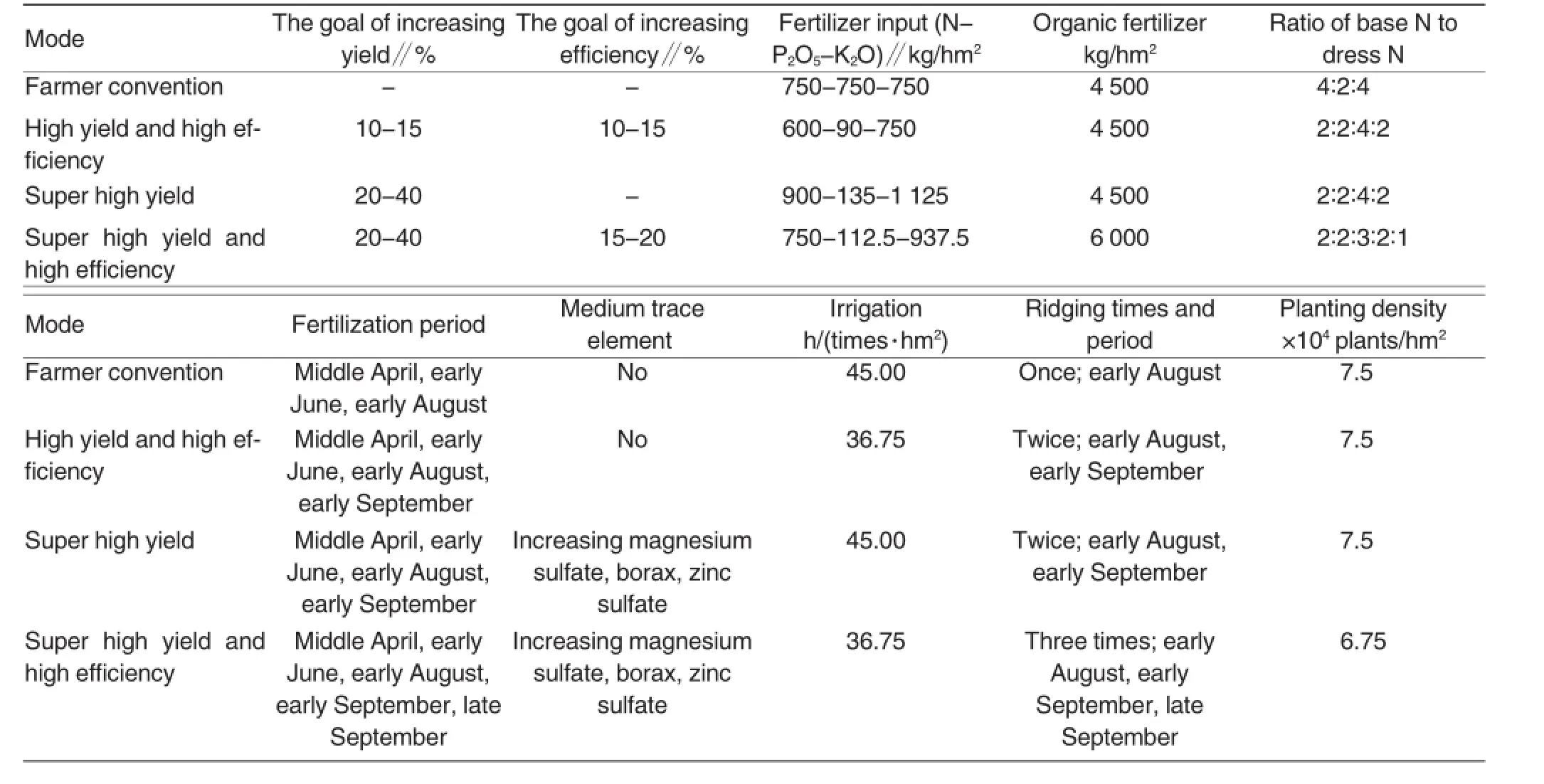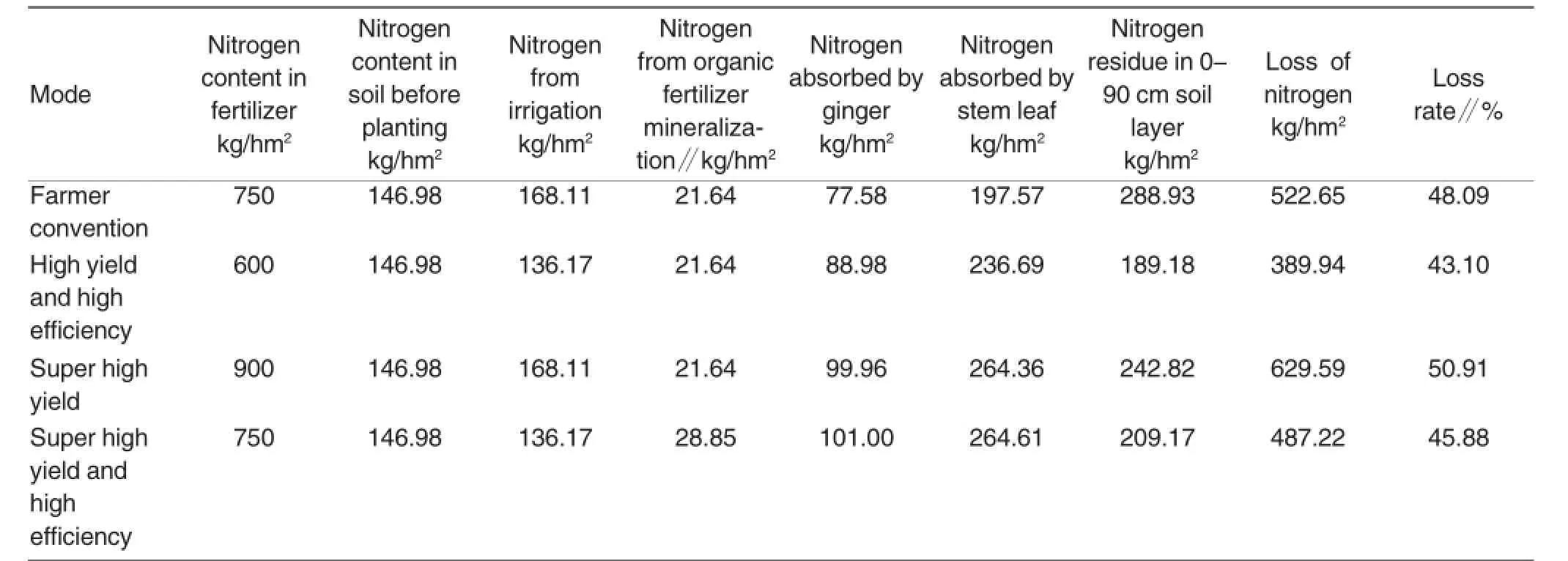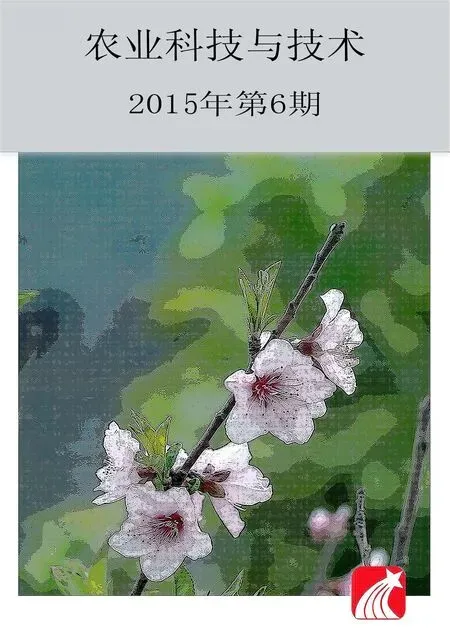Effects of Different Management Modes on Yield and Nutrient Efficiency of Ginger
2015-02-05FuliZHENGBosongZHANGYanGAOYeTIANZhengMADeshuiTANLihuaJIANG
Fuli ZHENG,Bosong ZHANG,Yan GAO,Ye TIAN,Zheng MA,Deshui TAN,Lihua JIANG
Agricultural Resources and Environment Institute,Shandong Academy of Agricultural Sciences,Ji’nan 250100,China
Effects of Different Management Modes on Yield and Nutrient Efficiency of Ginger
Fuli ZHENG,Bosong ZHANG,Yan GAO,Ye TIAN,Zheng MA,Deshui TAN,Lihua JIANG*
Agricultural Resources and Environment Institute,Shandong Academy of Agricultural Sciences,Ji’nan 250100,China
In order to establish high-yield and high-efficient cultivation technology for ginger in the central region of Shandong Province,the effects of different management modes on yield of ginger,nutrient efficiency and soil nitrate were carried out by field experiment.Four management modes were farmer convention mode,high yield and high efficiency mode,super high yield mode and super high yield and high efficiency mode,in which farmer convention mode was local farmers’conventional cropping methods,the other three management modes were optimized combinations of all management measures under a certain goal of increasing yield and efficiency.The results were as follows:ginger yield and nitrogen fertilizer efficiency under such three optimized management measures combinations as high yield and high efficiency mode,super high yield mode and super high yield and high efficiency mode were all higher than these of farmer convention mode,moreover,compared with farmer convention mode,the yield increased by 11.85%,25.75%and 23.34%,respectively,and nitrogen fertilizer efficiency increased by 47.94%,11.24% and 33.14%,respectively.Thereinto,the yield under super high yield mode were the greatest,and nitrogen fertilizer efficiency under high yield and high efficiency mode was the highest.
Different management modes;Ginger;Yield;Nutrient efficiency
G inger(Zingiber officinaleRoscoe)is a perennial plant of Zingiberaceae,its underground rhizome contains full-bodied and spicy volatile oil and gingerol,thus it has the functions of invigorating stomach,dispelling cold and relieving internal heat or fever,etc.,so it is one of the important condiments in peo ple’s daily life[1-2],it has been widely planted in tropical and subtropical areas[3].As one of the main ginger-growing countries of ginger[4],China has the largest cultivated area and the maximum yield of ginger in the world, for example,its annual cultivated area has reached 63×104hm2.Ginger is also one of the famous and special vegetable varieties in our country[5].By 2010,ginger area of Shandong Province had reached 6.67×104hm2, which mainly distributed in Laicheng District of Laiwu City,Daiyue District, Feichang District and Ningyang District of Tai’an City,Tengzhou Countylevel City of Zaozhuang City,Zichuan District,Boshan District and Yiyuan District of Zibo City,Anqiu Countylevel City and Zhucheng County-level City of Weifang City,etc.[6].However, there were still many problems in the fertilization,the survey showed that the unreasonable fertilization phenomena of blind and excess fertilization were very common,then followed by serious ginger diseases and insect pests,low and unstable yield,poor quality of rhizome and low economic benefit of ginger planting,which seriously restricted the development of ginger industry in China[1,7].Ginger is a crop needing a large amount of nitro gen[1],so nitrogen provided by soil alone is far from meeting the requirement of the growth and development of ginger.Reasonable application ofnitrogen fertilizer will directly influence the yield,the quality,economic benefit and the environment of ginger.The studies on the effects of nitrogen fertilizer on the yield and the quality of ginger have already been reported[8-12], which involved in the nutritive peculiarity and nutrient absorption law of ginger[13].The research indicated that reasonable application of nitrogen fertilizer can effectively improve the yield of ginger and perfect the quality of rhizome,these research results played an important role in promoting scientific fertilization of ginger.
Previous researches mainly concentrated on the effects of single factor management on ginger yield and efficiency of nitrogen fertilizer,however, the research on the effects of different management modes on yield of ginger,nutrient efficiency and soil nitrate was few.For this,based on local farmer convention mode,by field experiment,four management modes were proposed to study the effects of different management modes on yield of ginger,nutrient efficiency and soil nitrate,the aim was to provide a theoretical basis for high yield of ginger and high efficient utilization of resources.
Materials and Methods
General situation of experimental field
The experiment was carried out in Xiapo Village of Anqiu City in Shandong Province from April to October in 2010.The experimental variety was local variety—Anqiu ginger.The soil was browning moisture soil;before sowing,0-30 cm soil layer contained 0.937 g/kg total nitrogen(N),52.83 mg/kg rapidly available phosphorus (P),130.81 mg/kg rapidly available potassium(K)and 14.1 g/kg organic matter.
Experimental design
There were four modes in the experiment,such as farmer convention mode,high yield and high efficiency mode,super high yield mode and super high yield and high efficiency mode,in which farmer convention mode was local farmers’conventional cropping methods,the other three management modes were optimized combinations of all management measures under a certain goal of increasing yield and efficiency;compared with farmer convention mode,it was required that ginger yield and nitrogen fertilizer efficiency under high yield and high efficiency mode should be both increased by 10%-15%,and these under both super high yield mode and super high yield and high efficiency mode should be increased by 30%-40%.Each mode had three repetitions,and the area of each mode was 28 m2.The concrete proposal of the four modes was in Table 1.
The organic fertilizer was chicken manure ferment,which contained 33.19%organic matter,1.84%N, 5.87%P2O5and 1.98%K2O,the bottom fertilizer application of super high yield and high efficiency mode was 4 500 kg/hm2,then 1 500 kg/hm2fertilizer applied as topdressing combined with the first ridging,for the other three modes,the fertilizer was all used as bottom application.The phosphatic fertilizer was calcium superphosphate and used as bottom application;150 kg/hm2magnesium sulfate,15 kg/hm2sodium borate and 30 kg/hm2zinc sulfate were all used as bottom application;potash fertilizer was potassium sulphate and its dressing ratio was 4∶2∶3∶1,which should be applied as bottom application with nitrogenous fertilizer of high yield and high efficiency mode.
Measuring items and methods
Analysis of soil samplesKjeldahl determination was used to determine the content of total nitrogen,rapidly available phosphorus content was determined using 0.5 mol/L NaHCO3extraction and Mo-Sb colorimetry,rapidly available potassium was determined based on NH4AC extraction and flame photometer,and dichromate potassium-vitriol oxidation method was adopted to measure organic matter content[14].FIA5000 flow injection analysis was also used for the experiment.
Analysis of plant samplesAfter harvesting,the yield was measuredaccording to plot,10 plants from each plot were chosen to investigate their branching number,all plant samples should be measured after digesting in concentrated sulfuric acid-H2O2[14].

Table 1The experiment design scheme
Results and Analyses
Effects of different management modes on ginger yield and its component factors
As seen in Table 2,the yield under super high yield mode was 69 977 kg/hm2,ranking the first;the second was super high yield and high efficiency mode whose yield was 68 634 kg/hm2;compared with farmer convention mode,the yield of high yield and high efficiency mode,super high yield mode and super high yield and high efficiency mode respectively increased by 11.85%,25.75%and 23.33%,the three modes respectively had extremely significant differences with farmer convention mode;high yield and high efficiency mode achieved the goal of increasing 10%-15%of yield,super high yield mode and super high yield and high efficiency mode both achieved the goal of increasing 20%-40%of yield.Viewed from yield component,high yield and high efficiency mode had the most branching number per plant,and super high yield mode had the heaviest ginger per cluster,namely 933.13 g,super high yield and high efficiency mode had the second heaviest ginger per cluster,namely 915.13 g,the differences between the two were not obvious.It was obvious that the optimized management measures can remarkably improve branching number per plant and ginger weight per cluster, achieving the goal of increasing yield.
Evaluation on nitrogen fertilizer efficiency and economic benefit of ginger under different management modes
As shown in Table 3,there were great differences between nitrogen partial factor productivity and apparent recovery of nutrient under different modes;under high yield and high efficiency mode,both nitrogen partial factor productivity and apparent recovery of nutrient were the highest,namely 103.74 kg/kg and 54.28%,respectively,followed by super high yield and high efficiency mode,then super high yield mode,the lowest was farmer convention mode whose nitrogen partial factor productivity and apparent recovery of nutrient were 74.20 kg/kg and 36.39%,respectively.Compared with farmer convention mode,the nutrient efficiency under high yield and high efficiency mode improved by 47.94%,achieving the goal of increasing 10%-15%of nitrogen fertilizer efficiency;compared with super high yield mode,the nutrient efficiency under super high yield and high efficiency mode improved by 20.43%,also achieving the goal of increasing 15%-20%of nitrogen fertilizer efficiency,the three modes all achieved the goal of increasing both yield and revenue.According to the price of that year,the incomes under high yield and high efficiency mode,super high yield mode and super high yield and high efficiency mode respectively increased 52 736,114 624,103 883 yuan/hm2compared with farmer convention mode.Thus it can be seen that the optimized management measures can realize the goal of increasing yield, revenue and efficiency.
Apparent nitrogen balance under different management modes
Apparent nitrogen balance under different management modes was in Table 4,from the table,it can be seen that nitrogen loss amount and loss rate of super high yield mode were separately 629.59 kg/hm2and 50.91%, ranking the first,followed by farmer convention mode,then super high yield and high efficiency mode,the lowest was high yield and high efficiency mode whose nitrogen loss amount and loss rate were separately 389.94 kg/hm2and 43.10%,these were generally proportional to chemical nitrogen fertilizer input;the nitrogen input of super high yield mode was the highest,and that of high yield and high efficiency mode was the lowest,indicating that increasing nitrogen input also increased the risk of nitrogen loss. Therefore,the optimized manage-ment measures can decrease the loss of nitrogen to a certain extent,thus improving nitrogen efficiency.

Table 2Effects of different management modes on ginger yield and its component factors

Table 3Evaluation on nitrogen fertilizer efficiency and economic benefit of ginger under different management modes
Effects of different management modes on nitrate nitrogen content in the soil
Fig.1 was the distribution of nitrate nitrogen content in different growing periods and 0-90 cm soil layer after harvesting.Nitrate nitrogen content in the soil under different management modes showed the same trend,that was,nitrate nitrogen accumulation was the maximum when harvesting, which would decrease with the increase of soil depth;with the advance of growing period,nitrate nitrogen content in the soil would gradually increase,but in the earlier fast-growing period,nitrate nitrogen content in the soil may decrease because of more rainwater in that season.From Fig.1, although nitrate nitrogen content showed the same trend,nitrate nitrogen content in the soil under different management modes had great differences;nitrate nitrogen content in the soil under farmer convention mode was the highest,and that under super high yield mode was higher because of the most nitrogen application,nitrate nitrogen content under high yield and high efficiency mode and super high yield and high efficiency mode were both lower.These demonstrated that the optimized management measures can reduce nitrate nitrogen content in the soil,thereby reducing the risk of nitrate pollution in the groundwater.

Table 4Apparent nitrogen balance under different management modes
Conclusions and Discussions
The experiment results showed that ginger yield under different management modes showed significant differences,in which the yield under the three optimized modes of high yield and high efficiency,super high yield and super high yield and high efficiency respectively increased by 11.85%, 25.75%and 23.33%compared with farmer convention mode,moreover, high yield and high efficiency mode not only reduced nitrogen fertilizer application,but also improved ginger yield, achieving the expected goal of increasing yield;super high yield and high efficiency mode also achieved the goal of increasing 20%-40%yield by using the optimized management measures in the condition of not reducing nitrogen fertilizer application,what’s more,nitrate nitrogen content under high yield and high efficiency mode and super high yield and high efficiency mode was obviously lower than that under farmer convention mode, which showed that adjusting the ratio between basal fertilizer and top-dressing,optimizing water and fertilizer technique,increasing medium trace element application,appropriately reducing planting density and improving per unit yield can not only improve ginger yield,but also reduce the accumulation of nitrate nitrogen in the soil,thereby reducing the risk of the leaching loss of soil nitrate.
Viewed from nutrient efficiency of nitrogen fertilizer,high yield and high efficiency mode and super high yield and high efficiency mode both achieved the expected goal.Compared with farmer convention mode, the loss rate of nutrient under high yield and high efficiency mode decreased,and the nutrient efficiency improved by 47.94%;compared with super high yield mode,the loss rate of nutrient under super high yield and high efficiency mode also decreased, and the nutrient efficiency improved by 20.43%,these also achieved the goal of increasing nitrogen fertilizer efficien-cy,indicating that the optimized management measures,such as adjusting the ratio between basal fertilizer and top-dressing,adjusting irrigation methods and refining tillage methods, can realize the combination between high yield and high efficiency.
[1]HU FR(胡繁荣).Vegetable Cultivation (蔬菜栽培学)[M].Shanghai:Shanghai Jiao Tong University Press(上海:上海交通大学出版社),2003.
[2]WU XH(吴晓慧),GU GP(顾龚平), ZHANG WP(张卫明),et al.Development of studies on comprehensive utilization and processing techniques ofZingiber officinale(姜综合利用及深加工技术研究进展)[J].Chinese Wild Plant Resources(中国野生植物资源),2003, 22(3):5-9.
[3]ZHANG HZ(张宏志),GUAN ZX(管正学),WANG JL(王建立),et al.Utilization of GuizhouZingiber officinaleRoscoe (贵州生姜资源的应用研究)[J].Resources Science(资源科学),2001,23 (5):90-94.
[4]Ministry of Agriculture of the People’s Republic of China(农业部).The sown area and yield of vegetable all around China in 2006(2006年全国各地蔬菜播种面积和产量)[J].China Vegetables(中国蔬菜),2008(1):65-66.
[5]GE XG(葛晓光).Introduction of Olericulture(蔬菜学概论(北方本))[M].Beijing: China Agriculture Press(北京:中国农业出版社),1984.
[6]ZHAO DW(赵德婉).On principle and technique of high yield and superior quality cultivation of ginger(生姜优质丰产栽培原理与技术)[M].Beijing:China Agriculture Press(北京:中国农业出版社),2002:10-30.
[7]AI XZ(艾希珍),ZHAO DW(赵德婉),QU JR(曲静然),et al.Effects of fertilization level on the growth and yield of ginger (施肥水平对生姜生长及产量的影响)[J]. China Vegetables(中国蔬菜),1997(1): 18-21.
[8]XU K(徐坤),XU F(徐峰).Effects of nitrogen fertilizer on the growth and yield of ginger(氮肥对生姜生长及产量的影响) [J].China Vegetables(中国蔬菜),1999 (6):12-141.
[9]Lee MT,Asher CJ.Nitrogen nutrition of ginger——Effects of sources,rates and times of nitrogen application[J].Plant Soil,1998,62(1):23-34.
[10]Mathai CK.The pattern of rhizome yield and their accumulation of commercially important chemical constituents in turmeric during growth and development[J].Qualitas Plantarum, 2006,28(3):219-225.
[11]BEHURA S.Effect of nitrogen and potassium on growth parameters and rhizomatic characters of mango ginger [J].Ind.J.Agron.,200(46):747-751.
[12]XU K(徐坤),ZHENG GS(郑国生), WANG XF(王秀峰).Effects of nitrogen rates on colonial photosynthesis,yield and qualities of ginger(施氮量对生姜群体光合特性及产量和品质的影响)[J]. Plant Nutrition and Fertilizer Science (植物营养与肥料学报),2001,7(2): 189-1931.
[13]AI XZ(艾希珍),QU JR(曲静然),CUI ZF (崔志峰),et al.Effects of fertilization level on photosynthetic traits and NPK absorption(施肥水平对生姜光合特性及NPK吸收的影响)[J].China Vegetables(中国蔬菜),1997(5):87-91.
[14]LU RK(鲁如坤).Chemical Analysis Methods of Soil Agriculture(土壤农业化学分析方法)[M].Beijing:China Agriculture Science and Technology Press (北京:中国农业科技出版社),1999.
Responsible editor:Nanling WANG
Responsible proofreader:Xiaoyan WU
不同管理模式对生姜产量和养分效率的影响
郑福丽,张柏松,高燕,田叶,马征,谭德水,江丽华*
(山东省农业科学院农业资源与环境研究所,山东济南250100)
为了建立适合山东鲁中地区生姜高产高效栽培的技术体系,通过大田试验,研究了不同管理模式对生姜产量、养分效率及土壤硝酸盐的影响。4个管理模式分别为农民习惯模式、高产高效模式、再高产模式和再高产高效模式,其中农民习惯模式按当地农民常规种植进行,高产高效、再高产和再高产高效模式分别为设置一定增产增效目标下各种管理措施的优化组合。结果为:与农民习惯相比,高产高效、再高产和再高产高效3种模式均显著提高了生姜的产量和氮肥的养分效率,其中产量分别提高11.85%、25.75%和23.34%,氮肥养分效率分别提高47.94%、11.24%和33.14%。再高产模式下产量最高,高产高效模式下氮肥养分效率最高。
不同管理模式;生姜;产量;养分效率
公益性行业(农业)科研专项-葱姜蒜产业发展关键技术研究与开发(200903018);山东省科技发展计划项目(2013GGC02022)资助。
郑福丽(1979-),女,山东安丘人,硕士,助理研究员,主要从事施肥与土壤环境等方面的研究,E-mail:miss_xin@126.com。*通讯作者,E-mail:jiangli8227@sina.com。
2015-03-20
修回日期 2015-05-13
Supported by Agro-research Projects in Public Interest"Study and Development of Key Technology of Scallion,Ginger and Garlic Industry"(200903018);the Project of Shandong Science and Technology Development Plan(2013GGC02022).
*Corresponding author.E-mail:jiangli8227@sina.com
Received:March 20,2015 Accepted:May 13,2015
猜你喜欢
杂志排行
Agricultural Science & Technology的其它文章
- Analysis and Discussion on Some Problems of the Edible Fungi Production in Asmara Area
- The Control Research Progress ofLiberobacter asiaticumin Taizhou City
- Application of Genetically Modified Technology in Maize Breeding
- Breeding of Indica Rice CMS Line Renong 1A with Virescent-yellow Leaf
- Breeding and Application of Indica PTGMS Line Yan 161S and Its Hybrid Yanliangyou 1618 in Rice
- Thoughts on the Sustainable Development of the Fava Bean Industry in Chongqing
